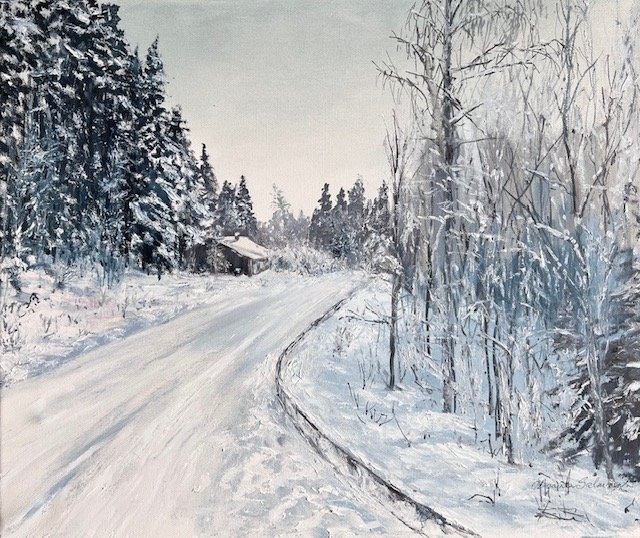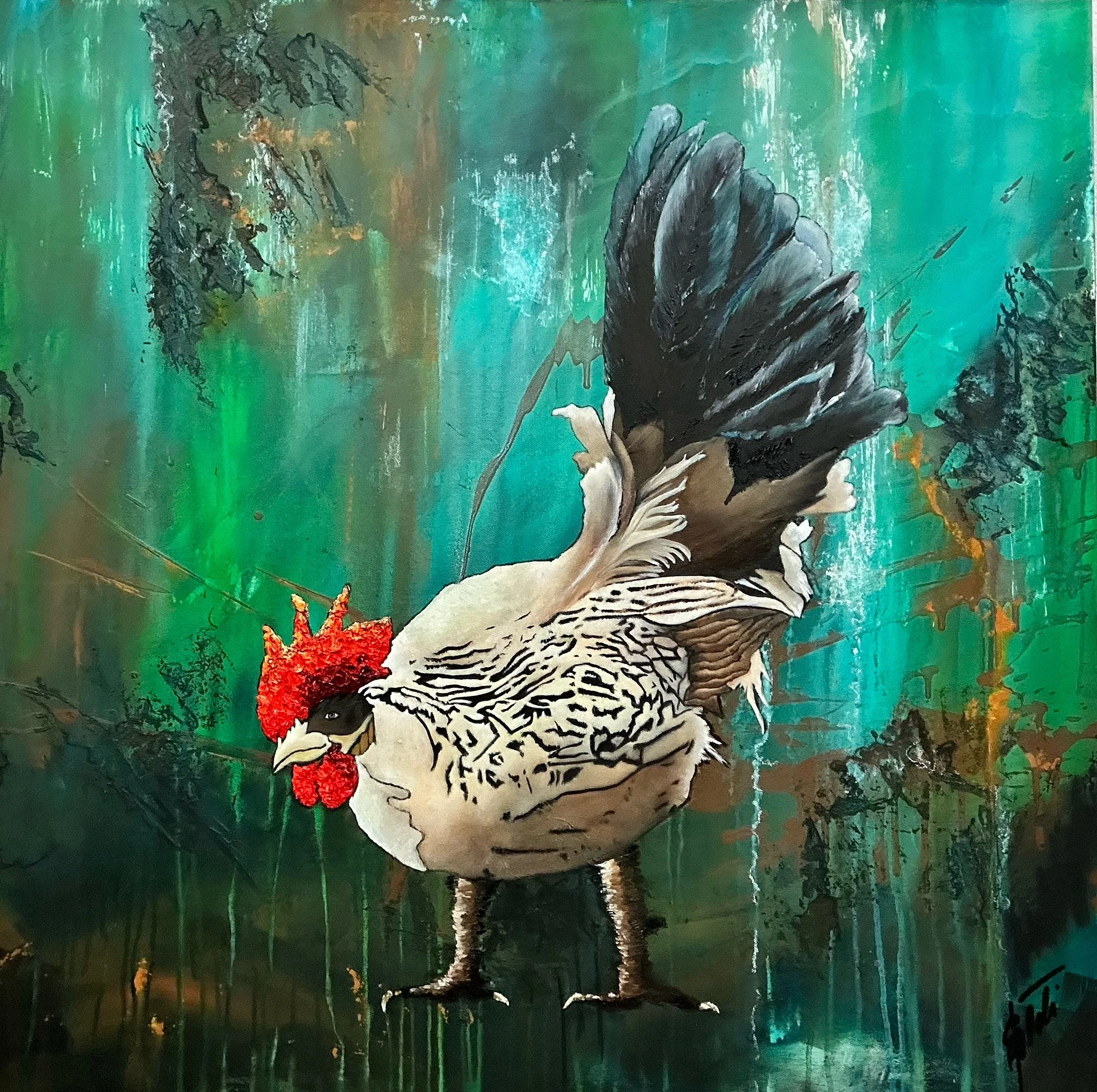Interview with Oksana Salminen
Your work often reflects the serene beauty of seascapes and landscapes from Estonia and Finland, as well as an underlying positivity. How do you reconcile painting tranquil scenes with the global issues that you acknowledge, like war and injustice? How does this tension shape your artistic vision?
Global issues affect us all and cause concern for me as well. However, it's impossible to be perpetually stressed or consumed by problems, as this can seriously harm our mental health. In the darkest times, having a glimmer of hope is crucial. There should always be a place to feel calm and safe, at least for some rest. Home should be that oasis of peace and stability where we can relax and recover. My paintings help with that and allow you to see beautiful and calming artworks at home.
You began your career in finance and law, fields that require analytical thinking and structure, before embracing art full-time. How do you feel this background influences your approach to art, especially in realism and abstraction? Are there aspects of your art that reflect this duality of structure and freedom?
When I paint, I must turn off the analysis and think more creatively, giving myself freedom. But in fact, analytical thinking does not hinder me, but helps me in my creativity, development, and promotion of art.
I started to draw and learn painting much earlier than I decided to link my career with finance and law. It took me some time and a lot of effort to develop the structure and analytical thinking necessary for successful studying and building a career in finance. However, it helps both in building a career in the corporate world and achieving set goals in creativity. Being an artist without structure, discipline, and analytical thinking is challenging. And discipline is what allows me to engage more consciously in creativity. Of course, my background in finance also probably unconsciously affects the choice of themes and styles of my artworks. Perhaps that’s why, at the moment, I’m more interested in realism with elements of abstraction than just pure abstraction.
Traveling seems to be a deep source of inspiration for you. Can you share an experience from your travels that profoundly influenced a particular piece or series? How do different cultures and landscapes reshape your perception of your own heritage?
Traveling is a great source of inspiration and impressions for me, and I always incorporate many references from my travels into my work. For example, my series of Mediterranean seascapes is entirely based on references from family trips to southern Europe.
And I like dual positiive impact of travelling. On the one hand, you admire the new and unusual things you see when you’re on a trip; on the other hand, when you come back, you start to notice and appreciate more what’s around you. You look at it with a fresh eye and you see the uniqueness and beauty of nature around.
Your childhood was closely tied to the sea due to your father's profession as a sea captain. How do you think the vastness and mystery of the sea have influenced your worldview and, by extension, your artistic expression?
Water and sea have always played a massive role in my life. From early childhood, I remember my impressions of walking by the sea, taking sea trips, and admiring the majestic and breathtaking nature of the sea. For me, the sea is associated with eternity, calmness, and continuity of life on earth. I like to feel this infinity of time and space, being by the sea or the ocean. I have always been fascinated by the noise of the waves, the sound of the wind, and that untransmittable feeling of freedom you can feel on the seashore. The desire to convey it all in my paintings inspires me when depicting seascapes. The sea is tough to communicate and fit in the picture because the canvas is tiny compared to the size of the sea or ocean, but I try very hard to do it. I also like to transmit the color of the water and waves. And to catch how waves change depending on the lighting and weather, they look majestic and bewitchingly beautiful in any light and at any time of the year.
In your artist's statement, you mention a desire to create beauty, kindness, and joy through your art. In today's art world, where complex and challenging subjects are often favored, how do you view the role of beauty and positivity in contemporary art?
Complex and challenging subjects do not have to be depressing; they can also carry positive energy transmitted through color, general mood, and spirit of the picture.
Estonian historical cities and Finnish natural landscapes feature prominently in your work. How do you view the relationship between cultural heritage and personal identity in your art? Do you see yourself as a cultural ambassador of sorts through your depictions of these places?
Through my paintings, I try to tell as many people as possible how amazingly beautiful the nature of these places is. I grew up here and believe that northern nature’s beauty is underestimated. It is considered more modest in color and brightness than the South, but this is untrue. The colors are mostly not so bright in winter because there are very short and, most often, cloudy days. But also, in winter, nature is terrific because of the fascinating crystals and the beauty of the snow, especially on a sunny day. And it is wonderful here in autumn - it’s just a riot of colors and such a diverse palette.
You often work with oils, watercolors, and soft pastels. How do these mediums help you express the "light and inspiring energy" you aim to convey in your art? Do you feel that each medium captures different emotional or thematic aspects of your work?
Each of these materials has its way of expressing and transmitting the idea of the painting. Most of the time, I work with oils. It is a material that is easy to experiment with and very pliable and flexible. At the same time, it can be no less airy, smooth, or tender as watercolor and pastel. All three of these materials can be used in such a way that it is sometimes challenging to say with which medium the picture is done. And I love that.
However, I wouldn’t say I strictly follow which aspect of the idea or theme is easier to convey, depending on the material. It’s more like the opposite - for example, sometimes you want to work on pastels, and then you know what topic you want to take. This is where freedom of expression comes in. I believe that only pictures written freely and easily can convey positive emotions. I know exactly and remember how, while studying, I had to create Works for learning purposes, which did not touch me emotionally, and I remember how difficult the work was with them.
The depiction of your daughters in your paintings suggests a deeply personal connection to your subjects. How does your relationship with your family influence the themes or tones of your pieces? Do they contribute in any way to your creative process?
Of course, my relationship with my family is very influential. They are my first audience and critics, and a source of inspiration for all my artwork. Family is my primary support and pillar in everything I do. And I can say that I would not be the person I am now without their support and inspiration.
You've spoken about wanting to make the world "a little bit more beautiful, kinder, brighter." How do you envision the impact of your art on viewers? Do you believe art has a responsibility to inspire positivity, and how does this influence the subjects or compositions you choose?
Art affects us directly and strongly. I strive for art to bring people joy, comfort, and positive energy. All my work aims at this. The sea, landscapes, flowers, animals, and people are my favorite subjects and the main objects in my pictures. I love to show the best and most beautiful part of them all.
I try to create my paintings so that people who have my artwork fill their homes only with positive and inspiring energy. I get a lot of thanks from collectors. It’s always very emotional and warm words and I understand that with my art, I give joy to collectors and bring some beauty to their lives. And it is incredibly inspiring and fills me, too!
Your recent exhibitions explore themes like identity, social inclusion, and the hybridization of identities and spaces. How do these complex themes align with or challenge your usual focus on beauty and positivity? Do you feel that contemporary issues alter the way you portray landscapes or figures in your work?
The relationship between a person and space is very close to me, and I am happy to participate in exhibitions dedicated to this topic. Solving contemporary problems can be approached from different sides, and showing beauty and positivity in the artworks is no less important than creating works that directly reflect acute social issues and wounds in our society. Art has a powerful influence and helps to solve problems in both cases.












